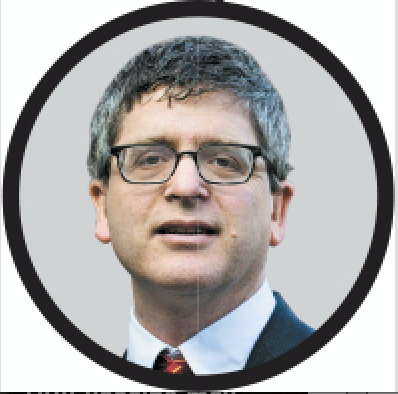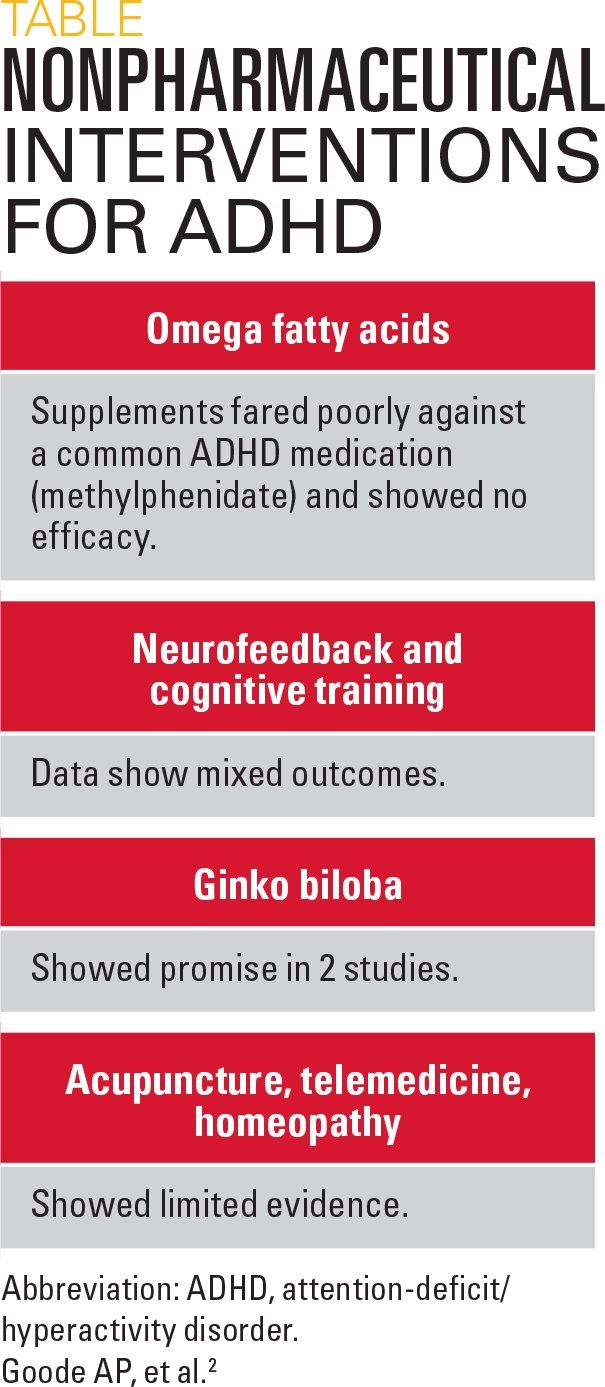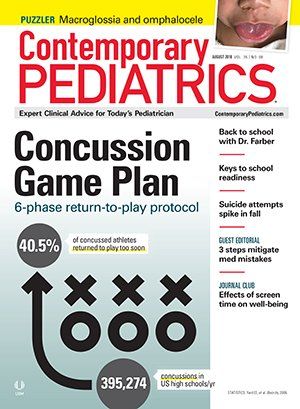Nonpharmacologic treatments for ADHD lack evidence base
A new study examined whether nonpharmacologic interventions for ADHD could support new guidance for their use.
Alex R Kemper, MD

Table

The Centers for Disease Control and Prevention (CDC) currently estimates that 6 million children and teenagers in the United States are diagnosed with attention-deficit/hyperactivity disorder (ADHD), the majority of whom (62%) are treated with ADHD medications.1
Although ADHD medications are considered the most effective treatment for older children and adolescents, the use of nonpharmacologic treatments alone or in combination with these medications has been a topic of much discussion and research.
“There are many approaches other than medications to treat ADHD, such as neurofeedback, cognitive behavioral therapy, or even dietary supplements,” says Alex R. Kemper, MD, division chief, Ambulatory Pediatrics, Nationwide Children’s Hospital, Columbus, Ohio. “We were interested in finding out how these treatments work, either alone or in combination with medications to improve ADHD symptoms.”
The “we” that Kemper refers to are his coinvestigators on a recently published meta-analysis in which they assessed the comparative effectiveness of nonpharmacologic treatments for ADHD.2
After a systematic review of the current evidence on nonpharmacologic treatments for ADHD, however, the investigators found no clear scientific evidence on the benefit of any of these treatments. “Unfortunately, we did not find the kind of scientific evidence that could help inform patients, families, or clinicians,” says Kemper, who is the senior author of the study.
Despite this, Kemper emphasizes that the lack of scientific evidence does not mean these treatments are not effective. Rather, he underscores the need for more studies on how best to treat ADHD.
Current scientific evidence: considerations for practice
Published in June 2018, the study included data from 54 studies of young persons aged 17 years and younger diagnosed with ADHD and treated with nonpharmacologic treatments alone or combined with ADHD medications. In all the studies, a nonpharmacologic intervention was compared to other nonpharmacologic interventions, and pharmacologic treatment approved by the US Food and Drug Administration (FDA), or usual care (placebo). All studies had at least 50 patients enrolled in the study.2
The types of nonpharmacologic interventions evaluated in these studies and assessed in the current meta-analysis included behavioral interventions (ie, neurofeedback, cognitive training, cognitive behavioral therapy, child or parent training) and dietary interventions (ie, dietary, herbal, or omega fatty acid supplements). Other interventions included acupuncture, homeopathy, and telemedicine.
When assessing the comparative effectiveness of these treatments, Kemper and colleagues found no scientific evidence to support new guidance on the use of any of these nonpharmacologic interventions for ADHD.
Perhaps the most solid bit of evidence comes from studies that compared omega fatty acid supplements, with no efficacy found in the studies that looked at these supplements.
Commenting on the study, Harlan R. Gephart, MD, clinical professor of Pediatrics emeritus, University of Washington School of Medicine, Seattle, pointed out several pieces of data from the study that, although largely not indicating evidence for or against, provide some additional information on specific nonpharmaceutical interventions (Table).
However, Gephart underscores that the lack of evidence base points to both the gaps in the current research as well as the rigorous requirements by the FDA for treatments to be approved as “evidence-based.”
Saying that the FDA requires at least 2 randomized control studies and 2 open label safety efficacy studies to consider a treatment for approval, Gephart indicates that this threshold pretty much closes the door for approval of nonpharmacologic treatments. “Very few nonmedication treatments even come close to meeting those requirements,” he says. “Most studies are flawed by sample biasing, inadequate number of cases, or other methodology issues.”
According to Gephart, the Multi-site Treatment of ADHD (MTA) study published in 1999 remains the gold standard for ADHD treatment.3 This study showed that parent training in behavior modification principles (eg, reward/consequence systems, token economies, daily behavioral report card, special behavior classrooms, summer programs) and use of stimulant medication, either alone or combined, are effective in treating ADHD. To date, these are the evidence-based treatments for ADHD.
Gephart notes that since the publication of this study, 2 other groups of nonstimulant medication have received FDA approval for ADHD treatment-an antidepressant (Strattera) and 2 alpha-agonist medications (Intuniv and Kapvay).
For Kemper, the key to effective treatment remains the use of stimulant medications but also may include nonpharmacologic approaches. “Just because we did not find scientific evidence, does not mean that these [nonpharmacologic] treatments are not effective,” he says.
“As a pediatrician, I believe that the most important approach is to personalize treatment,” Kemper says. “Other approaches, with or without medications, may be helpful.”
Frequent monitoring
Both Kemper and Gephart emphasize that frequent monitoring of children with ADHD is critical. “One of the most important components of managing ADHD is frequent assessment of symptoms and adjustment of treatment,” says Kemper.
For Gephart, this means monitoring at least every 3 months. “Optimal results have been shown by research with visits at least every 3 months, or 4 times yearly,” he says.
During these visits, pediatricians should be checking on things such as growth; medication effectiveness and adverse effects; school progress; and behavior at home and at school. “Make sure every follow-up appointment has information from both home and school,” he emphasizes.
More research is needed
Although the data to date do not provide sufficient scientific evidence to provide new guidance on using nonpharmacologic treatments for ADHD in young persons, both Kemper and Gephart urge more research to better understand how best to treat ADHD.
In particular, Gephart underscores the need for longer-term data from controlled research studies to better understand what works over the long term (at least 10 or more years).
The importance of this is highlighted by the chronic nature of the disease. Gephart points out that ADHD continues into adulthood in about 50% of children, and when not treated adequately can have lifelong consequences that adversely affect mental health, employment, and social relationships. “It is important to know this because the parents of our ADHD patients are often still struggling and need diagnosis and treatment,” he says.
References:
1. Centers for Disease Control and Prevention. Attention-deficit/hyperactivity disorder (ADHD). Data and statistics. Available at: https://www.cdc.gov/ncbddd/adhd/data.html. Updated March 20, 2018. Accessed July 11, 2018.
2. Goode AP, Coeytaux RR, Maslow GR, et al. Nonpharmacologic treatments for attention-deficit/hyperactivity disorder: a systematic review. Pediatrics. 2018;141(6):e20180094.
3. MTA Cooperative Group. A 14-month randomized clinical trial of treatment strategies for attention-deficit/hyperactivity disorder. Arch Gen Psychiatry. 1999;56(12):1073-1086. Available at: https://jamanetwork.com/journals/jamapsychiatry/fullarticle/205525 . Accessed July 11, 2018.

New research finds significant challenges for children with disabilities in foster care
September 27th 2024A study presented at the American Academy of Pediatrics 2024 National Conference finds children with disabilities in foster care face lower permanency rates and higher mortality risks, calling for specialized support and interventions.